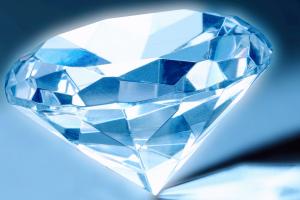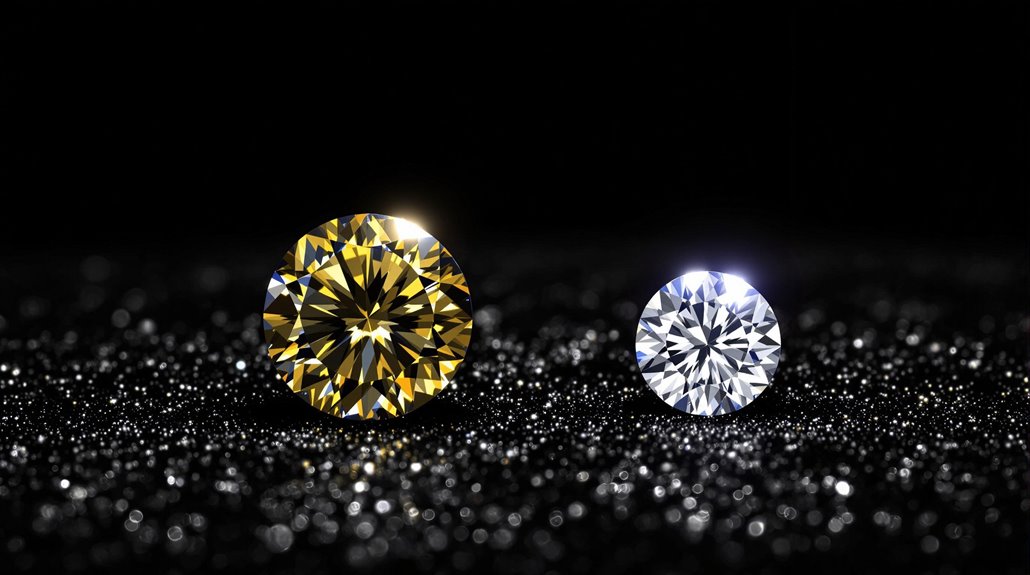Article Contents
- 1 Frequently Asked Questions
- 1.1 How Do Carat Weights Affect Insurance Premiums for Diamond Jewelry?
- 1.2 Can Diamond Carat Weight Be Accurately Measured at Home?
- 1.3 Do Lab-Grown Diamonds Follow the Same Carat Weight Pricing Structure?
- 1.4 What's the Most Popular Carat Weight for Engagement Rings Worldwide?
- 1.5 Does Resizing a Ring Setting Affect the Carat Weight Measurement?
Diamond carat weight significantly influences value, yet bigger doesn't always mean better. Although larger stones command premium prices because of their rarity, strategic buyers often find superior value in stones slightly below standard carat weights, such as 0.95 instead of 1.00. The interplay between size and other quality factors creates opportunities for savvy collectors to optimize their investment through careful consideration of cut, color, and clarity. Comprehending these subtle relationships unlocks the path to exceptional value.
In regards to evaluating diamond purchases, carat weight stands as one of the most pivotal yet frequently misunderstood factors in determining a stone's value. The all-encompassing diamond grading process reveals that although size matters significantly in market trends, it represents just one aspect of a complex quality assessment matrix. Four Cs system emerged in 1953 to bring objectivity to diamond evaluation.
Contemporary pricing structures reflect not just the physical dimensions but additionally the increasing rarity of larger stones, leading to exponential price increases that astute collectors must carefully consider. Consumer preferences often gravitate toward specific "magic numbers" in carat weights, though savvy buyers recognize that slight variations from these standard measurements can yield superior investment potential. The standardized modern carat system equals exactly 200 milligrams, providing precise measurements for valuation. Critical analysis of market data helps buyers make informed decisions about diamond investments.
The relationship between a diamond's size and its value follows a fascinating exponential curve, with prices increasing significantly as stones approach and exceed full-carat weights. A one-carat diamond, occurring roughly once in every million stones, commands a premium that reflects its relative scarcity. This rarity factor intensifies with size, as two-carat diamonds appear only once in five million stones, while three-carat specimens emerge just once in fifteen million stones, creating a compelling argument for their heightened market position. Well-cut diamonds can appear larger and more brilliant than their actual carat weight suggests.
Sophisticated buyers often discover that the most advantageous purchases lie just below the standard carat weights. For instance, selecting a 0.95-carat diamond instead of a full one-carat stone can result in substantial savings without a perceptible difference in appearance. This strategic approach to diamond acquisition allows collectors to optimize their investment during the desired aesthetic impact.
The interplay between carat weight and other quality factors presents an intriguing consideration for collectors. A smaller diamond with exceptional cut, color, and clarity characteristics may present superior value compared to a larger stone with compromised qualities. This delicate balance challenges the common assumption that bigger necessarily equals better in the domain of fine diamonds.
For those aiming to maximize their investment, grasping the relationship between size and value opens up creative possibilities. Some collectors opt for multiple smaller stones rather than a single large diamond, leveraging the non-linear pricing structure to their advantage. This approach not only provides more flexibility in design but can additionally result in more favorable overall value propositions.
The true art of diamond selection lies in finding the optimal balance between size and quality factors, all the while remaining mindful of budget constraints. Successful collectors recognize that although carat weight significantly influences a diamond's value, it should never be considered in isolation.
The most rewarding acquisitions often emerge from a thorough grasp of how size interacts with other quality parameters, leading to choices that satisfy both aesthetic desires and investment considerations.
Frequently Asked Questions
How Do Carat Weights Affect Insurance Premiums for Diamond Jewelry?
Insurance costs rise proportionally with diamond carat weight, as larger stones carry greater value. Premium calculations factor these weights directly when determining coverage amounts for protecting valuable diamond jewelry.
Can Diamond Carat Weight Be Accurately Measured at Home?
Home measurement of diamond carats lacks professional accuracy. Although basic digital diamond scales exist for home use, they cannot match the precision of professional equipment and expertise.
Do Lab-Grown Diamonds Follow the Same Carat Weight Pricing Structure?
Lab-grown diamonds are typically 40-50% less expensive than natural ones. Whereas both use carat weight for pricing, lab-grown diamonds don't follow the same exponential price increases across carat comparison ranges.
What's the Most Popular Carat Weight for Engagement Rings Worldwide?
Global average carat preferences vary significantly, with one carat being most popular in the U.S., whereas Europeans typically choose 0.5-0.6 carats, reflecting distinct societal significance in different regions.
Does Resizing a Ring Setting Affect the Carat Weight Measurement?
Although 95% of jewelers perform ring resizing services, the process does not affect a diamond's carat weight measurement. The stone's mass remains constant regardless of alterations to the setting.

